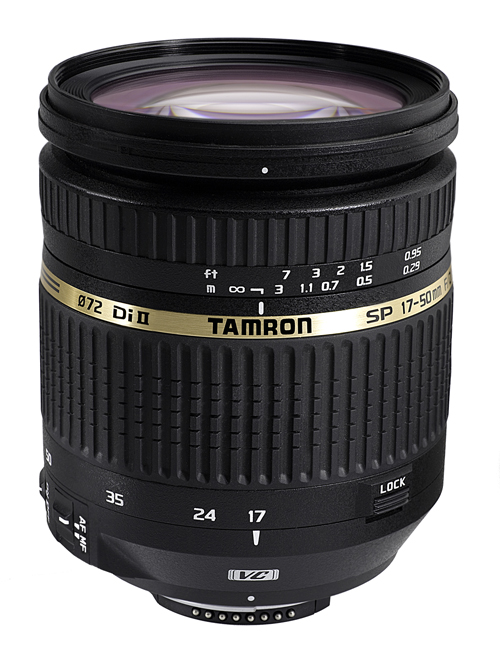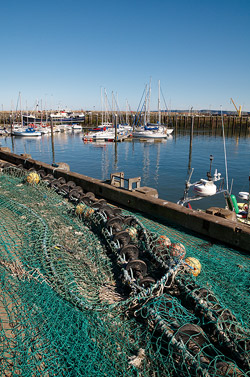Tamron SP AF 17-50mm f/2.8 VC XR Di ll LD
 |
| A fast aperture standard zoom with Vibration Compensation for Nikon or Canon APS-C sensor digital SLR cameras. |
Tamron's 17-50mm f/2.8 is a compact standard zoom with vibration compensation which costs around £460. Those looking into alternative will also find the original version of the lens, which lack the VC feature, retailing for around £334.
Pretty much all the main manufacturers now offer lenses covering this range. Sigma's 18-50mm f/2.8 EX DC OS HSM, offer optical stabilisation and a silent focusing motor for a slightly more hefty price tag of around £595. Sigma also offer a non-stabilised version, which is considerably cheaper at £330. Tokina's 16-50mm f/2.8 doesn't have any stabilisation and costs around £600, but is a little wider at 16mm.
Canon's offering in this range is the EF-S 17-55mm f/2.8 IS USM, which offers image stabilisation and silent focusing for around £829. Nikon's equivalent offering is their AF-S 17-55mm f/2.8, which doesn't offer stabilisation of any kind, but is a true professional quality lens in terms of build. This extra build quality unfortunately comes at a price, as this lens costs around £1040 at the current time.
As you can see, this Tamron is the lowest-priced lens to offer a stabilisation system along with a constant f/2.8 aperture. Here Gary Wolstenholme will take a look at whether the lower price tag represents good value.
Tamron SP AF 17-50mm f/2.8 VC XR Di ll LD: Handling and features
For a lens with a constant aperture of f/2.8, the Tamron 17-50mm is quite compact and lightweight, especially when compared to manufacturer's own offerings. To accommodate the VC system, this lens is a little larger and heavier than the non-stabilised version, but not by much. High quality plastics are used for much of the lens barrel construction, which helps keep the weight down.
Focusing is powered by a built-in motor, which makes no claims to be a silent one. Despite this the focus action isn't overly loud, and is comparably quick, locking onto subjects with little delay.
A third of a turn zooms the lens from 17mm to 50mm. I found the mechanism smooth, with enough resistance to prevent zoom creep becoming an issue. A lock is provided to prevent the lens extending during transport, keeping the lens set at 17mm. A narrower focus ring is located ahead of the zoom control. There is no way to disengage this control, so it whizzes back and forth during autofocus. Care needs to be taken to ensure you don't catch your fingers on the ring during operation.
Overall I liked the way this Tamron lens balanced and handled on the Nikon D80 used for testing. I also tried the lens on a Nikon D300 and it felt just as at home on there as the smaller D80.
Tamron SP AF 17-50mm f/2.8 VC XR Di ll LD: Performance
This lens put in a very good performance during testing. Very good results are possible at all focal lengths. As with many lenses, this optic performs best at it's shortest focal length. Here at 17mm the centre resolution is already excellent at f/2.8. Stopping down improves the sharpness towards the corners down to f/5.6, where the quality is verging on excellent across the frame.
As the lens is zoomed to 35mm, the lens still produces very high resulion in the centre, but the quality towards the edges has dropped off somewhat, especially. Stopping down to between f/5.6 and f/8 gives the best quality across the frame at this focal length.
And finally at 50mm, the quality at f/2.8 has dropped off somewhat, but is still acceptable. Stopping down the lens just one stop to f/4 provides very good resolution across the frame and just as at shorter focal length, the peak for sharpness is found at f/5.6.
Colour aberrations are kept below acceptable levels throughout the zoom range. At their worst they approach 0.75pixel widths at 35mm and f/5.6, which shouldn't pose any major issues under normal picture taking conditions.
For a fast aperture lens, falloff of illumination towards the corners is pretty well controlled. At 17mm and f/2.8 the corners are 1.74stops darker than the image centre. Here stopping down to f/5.6 provides virtually uniform illumination. At 50mm the amount of vignetting decreases. At f/2.8 the corners of the image are only 0.56stops darker than the image centre and illumination is pretty much uniform by f/4.
Distortion at 17mm is quite pronounced, which may cause some issues when straight lines are of importance. Here Imatest recorded 5.35% barrel distortion. At 50mm distortion is much less off an issue. There is still barrel distortion present, but at a much reduced amount of 0.44%. At both ends of the zoom the distortion pattern is uniform, so should be easy enough to correct in image editing software afterwards.
Flare and ghosting can be an issue with strong light sources in the frame, especially if the source of light is out of focus. Strong green/blue flare patterns can show emanating from the source of light. With light sources outside of the frame, this lens fares better, especially when the supplied petal-shaped hood is used. The hood does a sterling job of keeping extraneous light off the front element.
Tamron's Vibration Compensation feature can really help with low-light picture taking. I found that with good technique, sharp shots are possible much of the time at 1/8sec throughout the zoom range, which is excellent performance for such a system.
Tamron SP AF 17-50mm f/2.8 VC XR Di ll LD: Verdict
This lens has turned out to be a very interesting alternative to manufacturer's own offering in this focal range. It is capable of producing images with very good resolution, especially in the centre of the image and the Vibration Compensation feature has proved itself a worthy addition, greatly increasing your chances of achieving a sharp shot.
The lens does have some weaknesses, such as the falloff in resolution at 50mm and f/2.8 and its control of flare, but even at its weakest, the lens is still a capable tool. When the price is taken into consideration, this optic does represent excellent value for money.
Tamron SP AF 17-50mm f/2.8 VC XR Di ll LD: Pros
 Excellent resolution in the centre at most apertures and focal lengths
Excellent resolution in the centre at most apertures and focal lengths Vibration Compensation is very effective
Vibration Compensation is very effective Good value for money
Good value for moneyTamron SP AF 17-50mm f/2.8 VC XR Di ll LD: Cons
 Falloff in resolution at 50mm and f/2.8
Falloff in resolution at 50mm and f/2.8 Flare control
Flare control
| FEATURES |  |
| HANDLING |  |
| PERFORMANCE |  |
| VALUE |  |
| OVERALL |  |
Tamron SP AF 17-50mm f/2.8 VC XR Di ll LD: Lens specification
| Price | £460 |
| Contact | www.tamron.co.uk |
| Filter size | 72mm |
| Format | APS-C |
| Construction | 19 elements in 14 groups |
| Angle-of-view | 78°45'-31°11' |
| 35mm equivalent focal length (on APS-C body) | 25.5-75mm |
| Internal focusing | Yes |
| Image stabilisation | Yes |
| Minimum focus | 29cm |
| Maximum aperture | f/2.8 |
| Minimum aperture | f/32 |
| Weight | 570g |
| Size | 79.6x94.5mm |
| In the box | Petal shaped hood |
The Tamron SP AF 17-50mm f/2.8 VC XR Di ll LD costs around £460 and is available from Warehouse Express here:
Tamron SP AF 17-50mm f/2.8 VC XR Di ll LD Canon fit
Tamron SP AF 17-50mm f/2.8 VC XR Di ll LD Nikon fit
Add your message
Login required
Please login here or if you've not registered, you can register here. Registering is safe, quick and free.
Please login here or if you've not registered, you can register here. Registering is safe, quick and free.
photodo Stats
1102 lenses
428 MTF tests
74 in-depth photodo reviews
100+ users join each day
Help the lens community by reviewing or rating a lens today via our lens search
428 MTF tests
74 in-depth photodo reviews
100+ users join each day
Help the lens community by reviewing or rating a lens today via our lens search
Latest Lens Reviews
- Chinon 28mm f/2.8 Vintage Lens Review
- Canon EF 70-200mm f/4L IS II USM Lens Review
- Samyang AF 85mm f/1.4 EF Review
- Sigma 70mm f/2.8 DG Macro Art Review
- Samyang AF 24mm f/2.8 FE Review
- Meike 50mm f/1.7 Review
- Tamron 70-210mm f/4 Di VC USD Review
- Lensbaby Burnside 35mm f/2.8 Review
- Asahi Super Takumar 50mm f/1.4 Review
- Asahi Super-Multi-Coated Takumar 135mm f/3.5 Review








